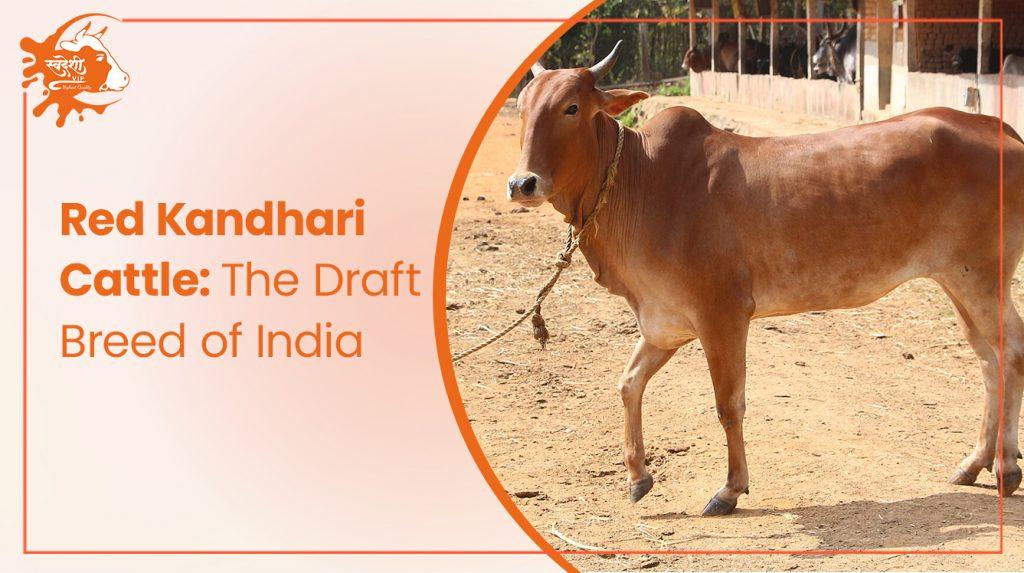
India’s cattle genetic biodiversity has been rich for ages. Around 30 well-defined breeds are spread over diverse agroecological zones. These 30 defined breeds are classified as draught, dual purpose, and milch. Indigenous cattle breeds have adapted to harsh and poor supervision in different levels of ecological disbalance over the past centuries. All these desi breeds are strongly resistant to scanty drinking water, dead grasses, and waste-quality crop leftovers. The breeds are described based on their field performances and yielding capacities.
This cattle breed, with its deep red-coloured skin, has been a significant part of Indian culture and history. It was used for domestic chores and was considered very important among all the other domestic animals. Cattle farming, a traditional business in rural India, has been very profitable with the Red Kandhari cattle. Notably, this breed served the royal patronage of King Somadevaraya, who ruled over Kandhar in 4 A.D.
The Red Kandhari cattle are one of the prominent draft breeds of the Marathwala region of Maharashtra state. They are utilised by farmers’ groups who want to make them work over draft utilities. Their original habitat is in Maharashtra, Kanpur, and small pockets of the Ahmedpur and Parli districts. This breed can be in the Bidar districts of Karnataka. This breed is well adapted to the agro-climatic conditions. The average size of this animal is robust, and the bull has a majestic style and posture, with energy and high spirit.
The red Kandhari cattle are not yet considered endangered per the conservation criteria; the Nanded district itself had 45,534 animals of the Lal Kandhari breed until 2003. The breed is abundant in various districts within its breeding area. Bullocks are well known for their excellent value from farmers and draft quality. This breed has a high disease-resistant capacity and requires minimal health care. This breed is a purebred known for its fixed characters.
The breed is medium in size, good-looking, strong, and robust. Its body is compact and not massive, and the limbs are proportionate. They are excellent carriers with a bright appearance. The body colour is dull red to dark brown. The body temperature also stays tame.
India has almost thirty known and recorded Indigenous cattle breeds, compared to many unknown or non-descriptive castles. In today’s time, most indigenous breeds are suffering a decline in the population due to their inefficiency. This draft breed has lost its utility because of modernisation in agriculture. It’s one of the popular cow breeds that belong to the league of top breeds such as Gir, Sahiwal, Rathi, etc. Hence, conservation is crucial.
As per studies, during 2011-2012, Maharashtra highlighted the limitations cattle rearers face regarding food shortage and grazing land. Improving milk-yielding and draught abilities needs proper attention, and the necessary efforts must be implemented. These Indigenous breeds can provide valuable resources for growing superior breeds. Hence, Indigenous cattle breeds must be conserved, developed, and flourished.
The breed’s unique characteristics and historical significance make it an asset to India’s agricultural biodiversity. The Red Kandhari cattle breed remains a critical component of India’s agricultural landscape, embodying the country’s traditional farming practices and resilience. This breed has evolved over centuries under the patronage of the royal dynasty of King Somadevraya, dating back to the 4th century AD. Its distinctive features, including a majestic gait, energetic disposition, and a deep red colouration, set it apart from other breeds. Its future hinges on continued efforts towards conservation and improvement, ensuring its legacy endures for generations to come.
These bullocks are used mainly for heavy agricultural work like ploughing, carting, and transportation.
This cow’s breed originates in the Kandhar taluka of the Nanded district of Maharashtra.
The price of all Kandhari cows is Rs 30,000. It may vary as well.
The breed is distinctly red and darker than Sahiwal. Its horns are thick at the base, emerge laterally, and curve upward.
Indigenous cattle are among the largest dairy breeds in India. They are highly valued because their capacity to produce milk is much higher and more nutritious.
This breed of cow produces a fair quantity of milk, an average of 598 kg per lactation, and an average fat percentage of 4.57%.
The birth weight of red Kandhari is 18-21 kg, and it attains 340-348 kg at calving.
